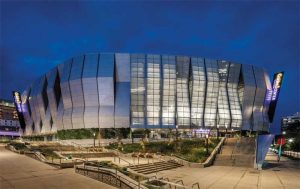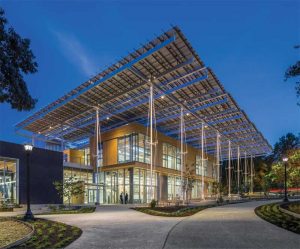
by Jennifer Gleisberg, CSI, CDT
When the project team decided to go green during construction, high-performance coatings might not be the first thing on their minds, but maybe they should be.
Every high-performance coating system is designed to guard surfaces against corrosion and ultraviolet (UV) light degradation, ultimately extending the life cycle of a building. So, the core goal of most industrial coatings is sustainability.
Innovation is key though, since the Leadership in Energy and Environmental Design (LEED) certification and the Living Building Challenge (LBC) standards limit the amount of allowable emissions from coatings. National air district regulations also narrow the field of choices for architects and specifiers tasked with selecting eco-conscious coatings. All of these sustainability requirements have restricted the use of solvent-borne products, forcing the industry to come up with inventive, low-emitting coating systems.
Over the last decade, newer technologies that can further preserve structures have become available. Manufacturers are working to create high-performance coatings with lower volatile organic compounds (VOCs) and to eliminate Red List chemicals from the mix as green building standards become increasingly common. The result is the development of more environmentally responsible and user-friendly coatings.
LEED and LBC
LEED v4, developed by the U.S. Green Building Council (USGBC), and LBC, developed by the International Living Future Institute (ILFI), are two of the most common green rating systems for architecture, engineering, and building.
The LEED rating system focuses on eight areas:
- Location and Transportation;
- Sustainable Sites;
- Water Efficiency;
- Energy and Atmosphere;
- Materials and Resources;
- Indoor Environmental Quality;
- Innovation; and
- Regional Priority.
Buildings are awarded points based on these categories and earn one of the following certifications: Certified, Silver, Gold, or Platinum.

LEED was first introduced in 1993 and continues to evolve. USGBC released LEED v4 in 2015 with new improvements over previous versions, including increased flexibility, an emphasis on materials and resources, and streamlined documentation.
As part of LEED v4, high-performance coatings must meet VOC requirements as well as the California Department of Public Health (CDPH) emissions testing for Low-emitting Materials Credit. CDPH’s emissions testing is the standard method for evaluating VOC emissions from indoor sources using environmental chambers. It is one of the most widely used standards to define and measure low-emitting interior products and materials.
“Prior to LEED v4, CDPH emissions testing was not required,” said Stephanie Dresen, global regulatory and sustainability specialist with a coatings manufacturer. “With the addition of this requirement, it is important for manufacturers to test their coatings to ensure they meet the newest requirements from the U.S. Green Building Council.”
The LBC certification includes a series of stringent performance requirements that a building must meet and maintain over a 12-month period of continuous operations and occupancy. To be certified, a structure is required to produce as much energy as it uses in a year, and capture and treat rainwater for all its needs for at least 12 continuous months. It also must meet the standards for the Red List-compliant materials and quality of its indoor environment.
LBC has the following seven performance areas, called petals, which the building must accomplish:
- Place – restores a healthy interrelationship with the natural world;
- Water – operates within the natural water balance of the building’s location;
- Energy – relies only on solar energy;
- Health and Happiness – creates an environment that prioritizes well-being;
- Equity – supports a just, equitable world;
- Beauty – design that uplifts the spirit; and
- Materials – uses only products that are safe for all species.




